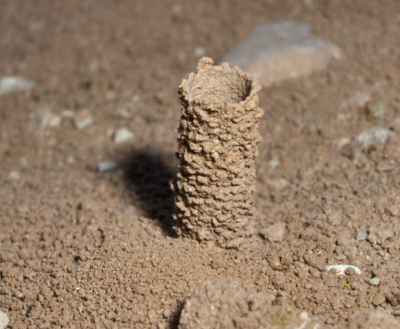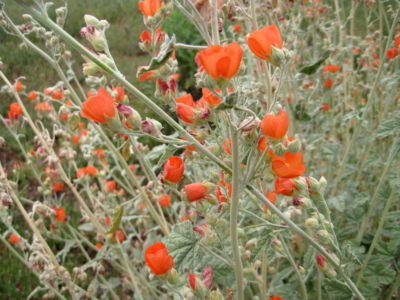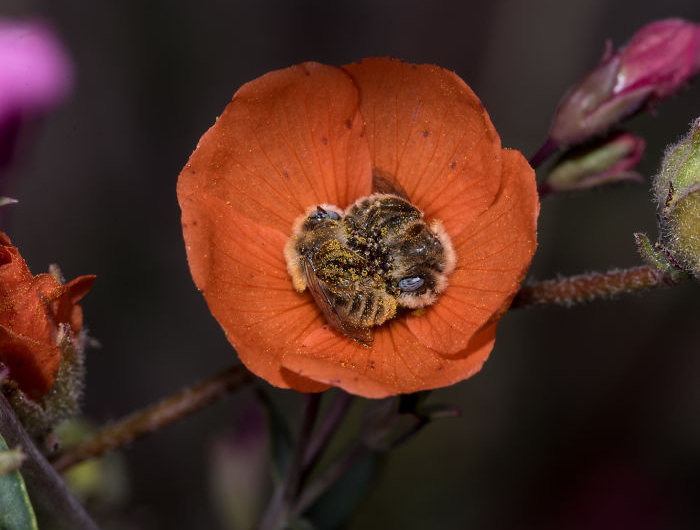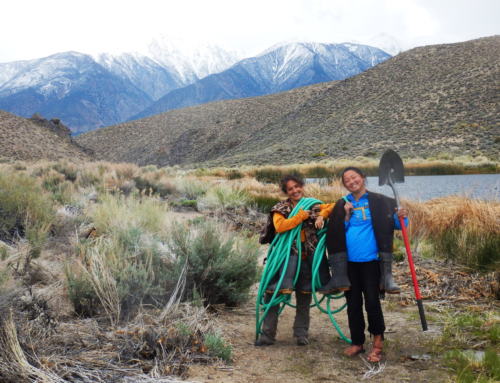Today is Saturday, and while you were probably sleeping in, it’s most likely that the bees were too. Have you ever seen a bee nap? Well today, National Pollinator Week Day 6, is dedicated to a little pollinator known for many things, and one of them is their notorious tendency to nap in flowers all dusted with pollen.
Have you ever fallen asleep after eating some cake to wake up and find yourself all covered in crumbs? Well let’s hope you look as cute as the Globe Mallow Bee all cozy in a Globe Mallow (or Apricot Mallow) flower.
Globe Mallow Bees, or Diadasia diminuta are some busy pollinators when they’re not napping. They are very exclusive pollinators, specializing in mostly the Globe Mallow (Sphaeralcea munroana), or for the Globe Mallow Bees of the Eastern Sierra: Desert Globe/Apricot Mallow (Sphaeralcea ambigua). This makes them an important native species to an equally important native plant in the Eastern Sierra. Sometimes these bees will enjoy the pollen of other mallows, sunflowers or even bindweeds.
Some facts about the Globe Mallow Bee:
- Like many native bees, they are solitary and females do most of the work.
- Similar to the mason and leafcutters, these bees also take pollen and nectar they’ve foraged to create a “loaf” or ball of food to provide to their eggs/larvae.
- They hold their pollen in built-in pouches behind their hind legs.
- Globe Mallow Bees burrow in the ground and make their nests there. Nearby these nests, the bees create turrets or chimneys that protrude from the ground. As these bees are still being studied, the US Forest Service records that:
“…the purpose [of the turrets] has long been debated. Do turrets 1) help keep rain or soil out of the nest, 2) help females recognize their nest when they return from foraging, or 3) discourage enemies? Investigation of this mystery continues.” –US Forest Service

Bee nest photo © 2011 Carol Davis
How can we support these native pollinators? Plant more native mallow in your home garden. Apricot Mallow, also known as desert globe mallow, or scientifically as Sphaeralcea ambigua, is preferred by these bees out here in the Eastern Sierra and here is some more information on this plant to help you support both a native bee and a native plant species at once!

Apricot mallow photo © 2010 Calscape
| Plant type | Perennial, flowering shrub |
| Size | 3-5ft tall; 2-4ft wide |
| Season | Evergreen |
| Flowering season | Spring & winter |
| Sun | Full sun |
| Moisture | Very low |
| Soil | Fast draining, desert-like soil |
Activities:
- Globe Mallow Coloring Page
- Share with us in the comments what you learned this week about pollinators!
Sleeping bee photo courtesy: Joe Neely, https://www.jmneelyphotography.com/






